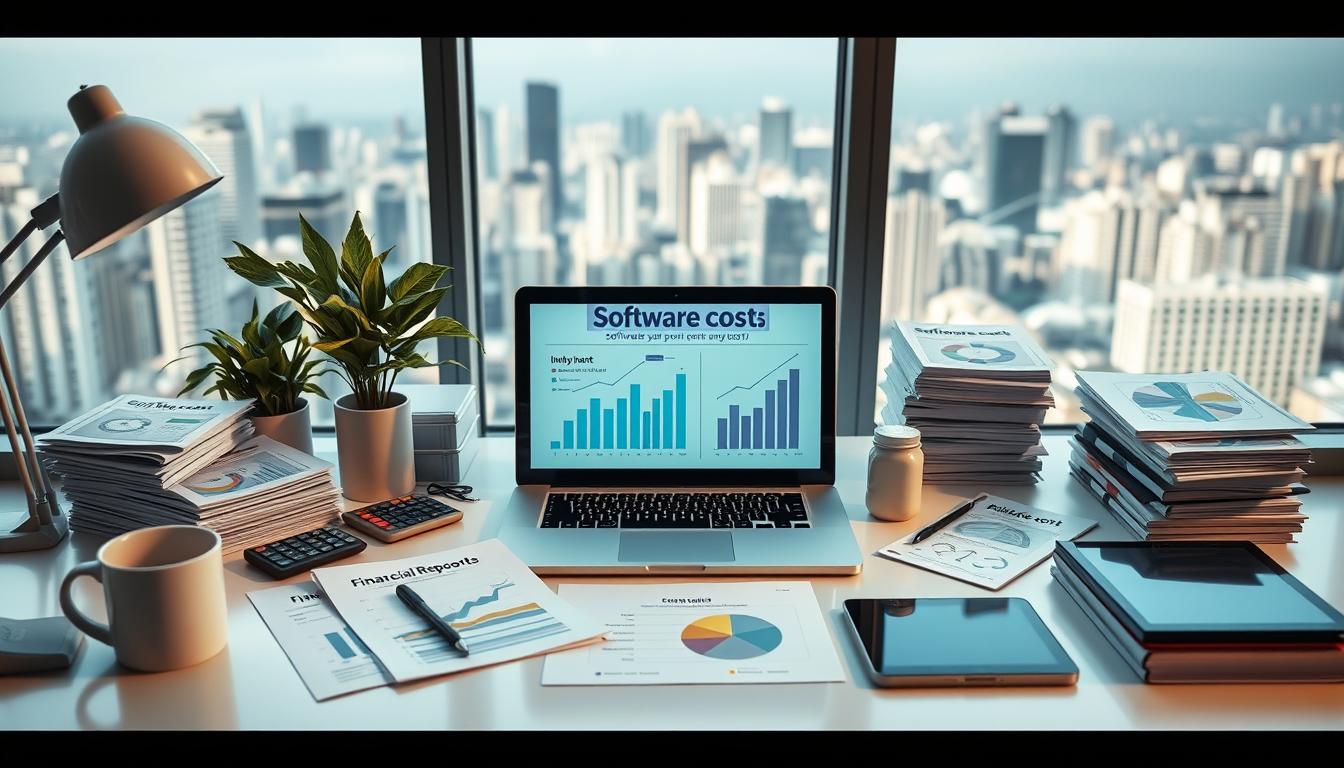For businesses, like restaurants, dealing with software costs is as tough as making a perfect dish. When it comes to Enterprise Resource Planning (ERP) systems, it’s key to know US Generally Accepted Accounting Principles (GAAP) well. It’s important to know which software costs to capitalize and which to expense right away for strong financial reports.
The Financial Accounting Standards Board (FASB) has updated rules for software costs, as seen in ASC 350-40 for Internal-Use Software. Their new rules help businesses use agile development methods better. The aim is to update the rules and make sure everyone follows them. This helps businesses show their financial health clearly and follow the law in their financial reports.
Table of Contents
Key Takeaways
- Understanding the importance of aligning with GAAP to correctly capitalize or expense ERP and GL software implementation costs.
- Distinguishing between different types of costs in software development and implementation stages.
- Recognizing direct and employee costs as potential capital investments, in contrast to preliminary expenses that must be expensed immediately.
- Utilizing methods such as straight-line or accelerated amortization for the systematic expense of capitalized software costs.
- Adhering to consistent financial reporting standards is necessary for accuracy, auditability, and stakeholder transparency.
Understanding the Basics of Software Cost Recognition
Technology keeps changing, and so does the world of software development. Knowing how to recognize software costs is key for companies to follow rules and report finances well. It’s important to get familiar with FASB regulations on software accounting to handle financial matters in the tech world.
The Evolving Landscape of Software Accounting
Technology moves fast, and so does the need to update accounting for software costs. The FASB keeps up by making rules clearer and encouraging careful decisions on when to capitalize or expense software costs. For example, moving from buying software licenses to subscribing to services changes how companies recognize costs.
Identifying Software Development Expenses
It’s crucial to correctly identify and group software development costs. FASB says costs from the early stages should be written off. But, during the actual development, some costs like fees and payroll might be capitalized if they help create and launch the software. This shows how important it is to be precise in accounting for software costs.
The Role of FASB in Software Cost Accounting
The Financial Accounting Standards Board (FASB) is key in setting software cost accounting standards. With rules like FASB ASU 2015-05 and ASU 2018-15, the board helps companies deal with different software costs. This affects how they capitalize and amortize costs.

| Stage of Development | Expense Treatment | Capitalization Opportunity |
|---|---|---|
| Preliminary Project Stage | Expensed | Not applicable |
| Application Development Stage | Selected costs expensed | Fees, Payroll, Specific Travel Costs |
| Post-Implementation/Operation Stage | Expensed | Maintenance Costs Allocable |
Grasping these parts of FASB regulations on software accounting helps with following rules and making smart financial decisions. As we face the tech world’s challenges, keeping up with these rules ensures our financial reports are right and show the current economic state.
Current Rules for Capitalizing Software Costs
In today’s world of finance and tech, knowing the rules for capitalizing software costs is key. It helps with accurate financial reports and following the law. This part talks about when to capitalize costs, especially for software used inside a company. It also looks at the challenges of using agile software development.
Criteria for Capitalization of Internal-Use Software
The ASC 350-40 guidelines say we must carefully track costs that can be capitalized. These are costs from the development phase of software for internal use. Capitalization starts when the project is likely to be finished and used as planned.
| Year Introduced | Standard | Description |
|---|---|---|
| 1985 | FASB Statement No. 86 | Initial guidance on accounting for costs of computer software developed or obtained for internal use. |
| 2007 | GASB Statement No. 51 | Guidance on accounting and financial reporting for intangible assets including software. |
| 2015 | ASC 350 | Intangible—Goodwill and Other, effective from 2016 with updates in 2018 (ASC 350-40). |
Agile Development and Capitalization Challenges
Agile development brings big challenges to software capitalization. Agile is all about being flexible and making progress in small steps. But, it doesn’t fit well with the traditional rules for capitalizing costs.
Agile’s impact on software amortization is huge. It makes it hard to tell what costs to capitalize and what to just spend. Companies must keep their capitalization rules up to date to follow FASB and agile methods.
To handle these issues, companies need to stay informed about updates like ASU 2018-15. This helps in reporting the costs of cloud computing correctly. It’s a step towards making financial rules work with the fast pace of tech.

Embracing the Shift: From Linear to Agile Software Development
The world of software development is changing fast. It’s moving from old ways to new agile development challenges. This change makes things faster and more flexible but also adds new problems in software project accounting. Agile methods need a new way to look at software cost recognition.

One big issue with Agile is figuring out how to track costs. Agile is all about quick cycles and changing plans often. This makes it hard to follow old accounting rules. It’s time to create new ways to account for costs that fit with Agile.
Dealing with agile development challenges means knowing when to count costs as investments. This means looking closely at what costs are worth tracking. The Financial Accounting Standards Board (FASB) helps set these rules. They make sure accounting keeps up with software development’s changes.
Agile has changed how software is made and how well it works. Companies using Agile saw fewer mistakes and faster work. This shows Agile can really improve how software is made.
Agile also changes how we plan and use resources in software project accounting. Unlike old ways, Agile lets resources move based on what’s needed now. This makes things more efficient and accurate. It helps match spending with what’s really needed and valuable.
In short, as more companies use Agile, they need to update their accounting. This makes sure they get the most out of Agile. Using Agile in accounting helps with money tracking and making smart choices. This leads to growth and new ideas.
Software Amortization Strategies for Accountants
Accountants now face new challenges with software amortization rules changing. The IRS’s recent update in Notice 2023-63 makes it clear how important it is to follow specific rules for software costs. These rules affect how software assets are reported and managed financially.
Amortization Periods and Methods
Choosing the right amortization periods is key. The IRS recommends a straight-line method for software depreciation over 36 months for software used outside the company. For software used inside, it suggests a longer period, usually five to seven years. This matches the software’s usefulness and how long it helps make money.
Impacts on Financial Statements
The way you account for software project accounting affects your company’s finances. Amortization changes asset values on balance sheets and affects net income through depreciation. It’s crucial to report these accurately for both following rules and planning financially. Tools like Thomson Reuters Fixed Assets CS® can help manage these complexities.
Also, new technologies like AI and VR, used by 63% of small businesses, need careful handling of software costs. This ensures financial reports show the company’s true financial health.
Effective software amortization strategies are more than just following rules. They help businesses show their financial reality. As technology becomes more important in business, understanding accounting for software costs is key for making smart decisions.
Addressing the Complexities of Software Project Accounting
Software project accounting needs careful attention and a solid framework. It handles the financial sides of software development. As tech advances and projects get more complex, precise software project accounting and software cost allocation are key.
Keeping up with innovation and quick project delivery is tough but vital. Accurate monitoring of software development expenses is crucial. It helps avoid going over budget and ensures projects are finished on time. This aligns financial plans with project work well.
Project Cost Allocation and Considerations
Software cost allocation splits project expenses among different parts of an organization. It includes direct costs like salaries and indirect costs like utilities. Knowing how these costs work together is vital for good budgeting and forecasting.
Monitoring Ongoing Development Expenditures
Managing a software project well means watching expenses closely. This lets you spot budget issues early and make changes quickly. It also helps see if the project is worth the cost and how to manage money better.
Recently, the Financial Accounting Standards Board (FASB) suggested changes to ASC 350-40. These aim to make tracking software costs easier. They also want to show cash flows clearly in software development. This makes tracking and reporting in software project accounting even more important.
In summary, software project accounting is complex and needs a flexible approach. As projects get bigger and more complicated, good financial management is key. It drives success and keeps costs down.
Accounting for Cloud Computing Arrangements
The world of accounting for cloud computing, especially SaaS, is changing fast. It’s important for businesses to understand these changes to stay compliant and improve their finances. The new ASU 2018-15 helps align costs with internal-use software rules.
Understanding SaaS and its Financial Impacts
SaaS changes how we spend money from big upfront costs to ongoing expenses. This affects budgets, taxes, and how we report finances. The cost of starting up with cloud services can be high, but it helps with cash flow and budgeting.
Distinguishing Between Service Contracts and Licenses
It’s key to tell apart service contracts from software licenses in cloud accounting. Costs for service contracts are reported differently than for software licenses. This affects how we see these costs in financial reports.
Following new cloud standards helps businesses stay compliant and improve their finances. Cloud solutions can make accounting easier, leading to better tax positions and financial health.
In summary, new rules like ASU 2018-151 have changed how we account for SaaS and cloud services. Businesses should update their accounting policies to reflect these changes. This ensures accurate and detailed financial reporting.
Software Development and Operational Expense Reporting
Managing software development costs and reporting expenses is key today. With more companies using cloud services, it’s vital to understand cloud financial reporting. This knowledge helps in managing software costs and cash flows.
CCA’s Financial Reporting Presentation
Cloud Computing Arrangements (CCAs) bring new challenges to financial reporting. They change how we view expenses, moving from capital to operational costs. This affects EBITDA, making cloud financial reporting strategies crucial.
The Financial Accounting Standards Board (FASB) says this change is big. It changes how we see a company’s financial health. So, detailed reports on operational expenses are needed.
Software Costs on Cash Flow Statements
It’s important to know how software costs flow in both traditional and cloud models. The FASB has updated guidelines for software costs. This includes clearer rules for disclosures and handling capitalized costs.
These updates help in presenting software costs in cash flow statements. It makes it easier for stakeholders to see how well a company operates and uses its assets.
| Aspect | Pre-Amendment Treatment | Post-Amendment Expectations |
|---|---|---|
| Capitalized Software Costs | Part of investing activities | Separately listed, enhancing transparency |
| Cloud Computing Costs | Operational expenses | Maintained as operational, with detailed reporting |
| Disclosure Requirements | Limited details required | Enhanced transparency in reporting expected |
| Technological Feasibility | Defined post iterations in agile environments | Clear guidelines anticipated for earlier recognition of expenses |
Software Asset Accounting for SaaS and Cloud Models
Cloud computing has changed how we manage software assets. Now, software asset accounting for SaaS and cloud models accounting is key. The Financial Accounting Standards Board (FASB) has set new standards to help with these tasks.
Deloitte’s insights show why we need clear accounting rules. FASB’s ASU 2015-05 and ASU 2018-15 give us the guidelines. They help us understand how to handle fees in cloud arrangements.
These guidelines let us capitalize implementation costs in cloud arrangements. This affects how we report costs on financial statements. It’s important for companies using cloud models to follow these rules.
| Update | Content | Impact on Accounting |
|---|---|---|
| ASU 2015-05 | Aligns software license determination in CCAs with vendor guidelines | Clarifies capitalization of software costs without direct license transfer |
| ASU 2018-15 | Guides accounting for implementation costs in hosting services classified as service contracts | Allows capitalization of costs, affecting financial statements presentation |
| ASC 350-40 | Defines stages of development for internal-use software | Specifies what costs can be capitalized during the application development stage |
Companies must estimate the costs of implementation services. This is important because it affects how we capitalize these expenses.
Adopting ASU 2018-15 can be done in two ways. Companies must disclose the change in accounting principles. This helps stakeholders understand the financial health of the company.
Good software asset accounting for SaaS and cloud models makes financial reports clear. It helps companies use cloud technology while staying compliant.
Delving into the Guidance on Software to Be Sold or Marketed
Today, small businesses rely heavily on software. This makes it crucial to understand how to handle costs for software meant for others. ASC 985-20 provides key rules for accounting for marketed software. It helps with the costs of developing software for sale or licensing.
Software plays a big role in small businesses, with 93% using it to improve operations. This highlights the need for smart external-use software purchases strategies. Looking at desktop accounting options like DEVMET or, shows how ASC 985-20 is even more important.
Application of ASC 985-20 Standards
This standard is key for businesses wanting to capitalize on development costs for marketed software. Following it helps manage costs better. For example, software meant for leasing should have direct costs capitalized during development under ASC 985-20.
Considerations for External-Use Software Purchases
Buying software for others to use requires careful thought. It’s important to consider the software’s use, whether it’s a one-time or term-based license. With 83% of small businesses planning to use more technology, understanding accounting for marketed software is crucial.
ASC 985-20 aims to make financial statements reflect the true costs of software. It stresses the need for detailed records and financial planning. This helps businesses track development costs against future benefits.
| Software Type | Capitalization Rate | Amortization Period |
|---|---|---|
| Internal-use Software | Capitalized over development phase | 5-7 years |
| External-use Software | 80% Bonus Depreciation | Useful life (typically 3-5 years) |
Following ASC 985-20 helps with planning and budgeting. This is vital as 63% of small businesses want to adopt new tech like AI and VR. Mastering these rules not only ensures compliance but also boosts a business’s growth.
Strategizing Software Cost Allocation Across Projects
Software cost allocation is key in managing software development finances. It helps follow accounting rules and guides budgeting and strategy.
It involves carefully spreading out costs across projects. Direct costs, like software licenses, are easy to track. Indirect costs, like overheads, are harder to assign to specific projects.
In agile settings, using software project accounting strategies is vital. Agile projects, with their fast cycles, need a flexible cost tracking approach.
- Direct Allocation: Directly assigns costs to projects when a clear relationship exists.
- Step-down Allocation: Uses a hierarchical approach to distribute costs from the general to the specific.
- Reciprocal Allocation: Handles interdepartmental dependencies, appropriate in complex project structures.
- Activity-Based Costing (ABC): Allocates costs based on activities that consume resources, providing a more accurate reflection of resource usage.
Each strategy has its own benefits for cost reporting. The right method depends on the business, project type, and financial analysis needs.
Agile projects make cost tracking harder because of their fast pace. Costs are tracked by sprint to keep up with changes. Accountants need to be flexible to handle these changes.
Keeping software cost allocation consistent is crucial. It ensures financial data remains reliable over time. Regularly reviewing and updating strategies is important for new challenges and tech advancements.
Effective software cost allocation leads to better financial visibility, enabling informed strategic decisions that drive business success.
Challenges and Considerations: Accountants face challenges like differentiating cost types and capitalizing versus expensing. Agile projects make these harder due to their fluid nature.
In conclusion, managing software costs well is essential for financial reporting and project management. Companies that master software project accounting can better manage their investments and grow their business.
How to Adapt to New FASB Tentative Decisions on Software Costs
The Financial Accounting Standards Board (FASB) has made big changes. These changes affect how companies handle software costs. It’s important for businesses to understand these FASB tentative decisions to stay on track financially.
Proposed Changes to ASC 350-40 and 350-50
ASC 350-40 deals with software costs for internal use. The FASB wants to change how these costs are handled. They want to make it easier to decide what costs to keep track of.
Changes to ASC 350-50 focus on website development costs. Companies will have to be clearer about these costs in their financial reports.
The Impact of the Proposed Accounting Standards Update
The new rules will change how companies report software costs. This could affect their cash flow statements. Companies need to get better at tracking and reporting these costs.
The new rules also want companies to show software costs clearly. This helps investors understand how much money is going into software projects.
Prospective transition and retrospective application options will require organizations to recalibrate their financial statements in accordance with the new standards, inviting a phase of adjustment and meticulous review of existing accounting practices.
| Key Parameter | Current Guideline | Proposed Change |
|---|---|---|
| Capitalization of Costs | Based on project stage | Focus on functionality and performance uncertainty |
| Cash Flow Statement Presentation | Aggregated costs | Separate disclosure of software costs |
| Feedback Period Deadline | Not applicable | January 27, 2025 |
Changing to these new rules takes a lot of work. Companies need to update their systems and train their staff. They might also need to change their financial plans. Getting help from experts in FASB tentative decisions and proposed Accounting Standards Update can be very helpful.
Implications of the FASB’s Decisions for Software Asset Accounting
The Financial Accounting Standards Board (FASB) is making big changes in software asset accounting implications. These changes, outlined in ASU No. 2024-ED400, focus on how to handle software development costs. They aim to keep up with new accounting for software costs methods.
Comments on these proposals are due by January 27, 2025. The goal is to make FASB regulations on software accounting match today’s software development. This is because old accounting ways don’t fit with the fast pace of new software development.
Companies use different ways to develop software, like ‘waterfall’ and ‘agile development.’ The new FASB rules might make more software costs expensed. This could be a problem, especially with a new “probable-to-complete” rule.
The new rules will change how companies report and value software costs. This could affect their financial plans and how they see their assets. Companies will have options to adjust to these new rules, which could help with complex projects.
ASC 985-20 is key in these changes. It deals with the accounting for software to be sold, leased, or marketed. This standard applies to both internal and external software costs, ensuring a consistent approach.
Software costs for services are also covered by ASC 985-20. This makes financial reports clearer and more consistent, especially in industries that rely heavily on software.
In summary, the changing FASB regulations on software accounting require careful attention from businesses. Companies need to stay informed and ready for the possible increase in expensed software costs. This could affect their financial statements and plans.
Conclusion: Accounting for Software Costs
The journey into accounting for software costs shows a world shaped by FASB regulations and changing software cost rules. Companies like Google, Amazon, and Facebook use new methods that match fast innovation. They don’t capitalize R&D costs.
A good financial plan that follows FASB’s software cost rules is key. It helps companies stay compliant and keeps their finances strong in today’s fast-paced digital world.
| Aspect | Impact | Industry Practice |
|---|---|---|
| Capitalization vs. Expense Recognition | Improves short-term profits; aligns cost with innovation | Expense by tech giants for flexibility & innovation speed |
| Amortization of Software Costs | Allows tax deferrals, affects ROA and EBITDA | Used sparingly in tech industries to maintain agile development cycles |
| Regulatory Compliance | Ensures transparency and accuracy in financial reporting | Adhered to by companies to align with FASB regulations and standards |
Keeping up with software cost guidance from key bodies needs a forward-thinking mindset. It’s about being ready for changes and knowing how they affect money matters. This readiness helps companies follow rules and make smart choices for the future of software costs.
Sage Wisdom: Software Cost Accounting and Asset Management
Mastering software cost accounting and asset management shows true wisdom. It involves following Generally Accepted Accounting Principles (GAAP) closely. This is key to managing assets well.
Companies must decide if software costs are immediate expenses or long-term assets. This choice affects their financial reports and how well they run. It gives them an edge in a world driven by technology.
Using software cost accounting wisely helps businesses avoid risks and work better. For instance, Fixed Assets software cuts down on accounting work. It also helps find extra tax payments and insurance costs.
Switching to Fixed Assets software can save time and money. It makes work more efficient and reduces mistakes from manual entry.
Staying true to software accounting standards is crucial. Companies need to follow the Financial Accounting Standards Board (FASB). Organizations like Paragon International, Inc. offer valuable help since 1985.
They show the importance of careful depreciation, tax rules, and asset management. Their expertise helps businesses get their finances right.
